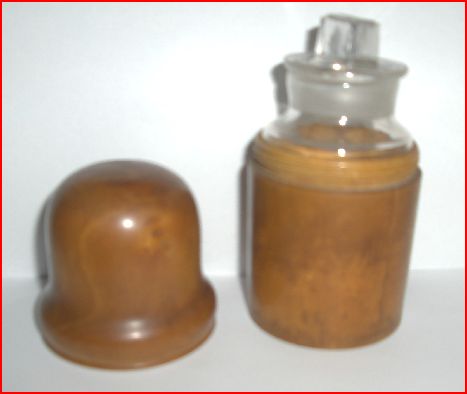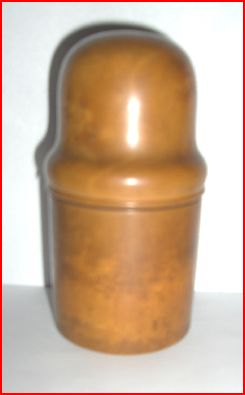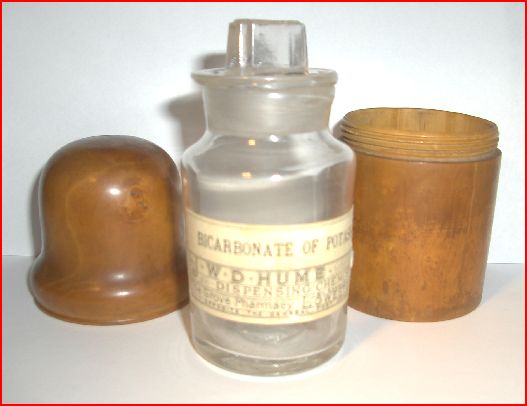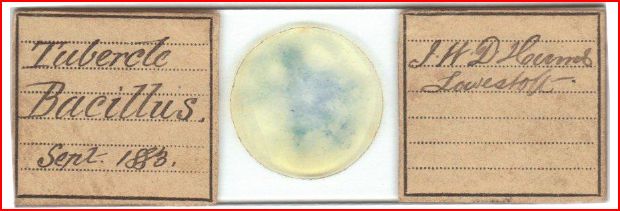
A FOOTNOTE ON HUME
Peter B. Paisley
Sydney, Australia
Articles in Micscape – mine, anyway – stimulate few reactions from readers: certainly none more serendipitous than that which leads to this footnote on Hume. The pharmacist J.W.D. Hume made highly competent mounts over a period of some decades. Few of his slides turn up these days: I used several from my own collection to illustrate a previous Micscape article, and it was a very pleasant surprise when a UK reader offered me a pharmacy dispensing bottle, issued from Hume’s first Lowestoft premises, the Grove Pharmacy, opposite the Lowestoft General Post Office. The little bottle, enclosed in a handsome screw top wooden case, is illustrated below.

The item, when completely enclosed, measures four and a quarter inches in height by two inches in diameter (I use old money measurement): the bottle dates from the 1880s, before Hume moved to new premises in London Road, Lowestoft. Presumably it was well protected from breakage when the wooden top was securely fastened, as seen below. It was also protected from spillage in any recipient’s pocket.

The bottle, long since empty, originally contained potassium bicarbonate. If prescribed for a patient, for whom it was dispensed, and its therapeutic purpose, are unknown. It is likely though that both patient and prescribing doctor were in Lowestoft, or the surrounding area.

Hume took an active interest in human histology and pathology, as evidenced for instance in mounts of material from patients, like that shown below (and illustrated in my article in the April 2010 Micscape).

The sputum slide above dates from not long after staining for mycobacteria was first described: while the causative agent was now demonstrable, target antibacterial therapy lay far in the future. Chronic diseases like TB attracted all manner of regimens, from “rest cures” to homeopathy and much else beyond. Hume’s potassium bicarbonate may not have been a homeopathic preparation, but the bottle illustrated in this article came to me via a family who include a homeopathic physician among their ancestors. By the end of the nineteenth century, homeopathy was discredited as bereft of evidential or theoretical foundation: but in the 1880s it still attracted a considerable following among otherwise orthodox registered medical practitioners. Since infectious disease was a major killer more or less without specific remedy, other than preventive measures by vaccination, some doctors tried methods outside the mainstream, which so often achieved little or nothing. Of course, some patients recovered regardless of intervention (or not) by whatever method, encouraging perpetuation of post hoc fallacies, as remains the case today. Lowestoft and its environs sustain a thriving homeopathic industry today, and the Lowestoft Boots’ pharmacy (active in Hume’s time) offers homeopathic remedies.
Unhappily I have been unable to trace any specific connection, by name, between my donor family and medical practitioners of Hume’s time in Lowestoft. Perhaps some reader may know something! Whatever the case, it is unusual and pleasing to find ancillary material from bygone mounters, especially one so underdocumented as Hume.
Comments to the author will be welcomed.
Acknowledgement
Many thanks to David Watkinson, who sent me the Hume bottle. His grandfather, William Thompson Walker, was a homeopathic physician in Tunbridge Wells and a consultant at the London Homeopathic Hospital: the bottle was among Dr. Walker’s possessions.
Microscopy UK Front
Page
Micscape
Magazine
Article
Library
Published in the August 2011 edition of Micscape Magazine.
Please report any Web problems or offer general comments to the Micscape Editor .
Micscape is the on-line monthly magazine of the Microscopy UK website at Microscopy-UK .
© Onview.net Ltd, Microscopy-UK, and all contributors 1995 onwards. All rights reserved. Main site is at www.microscopy-uk.org.uk .